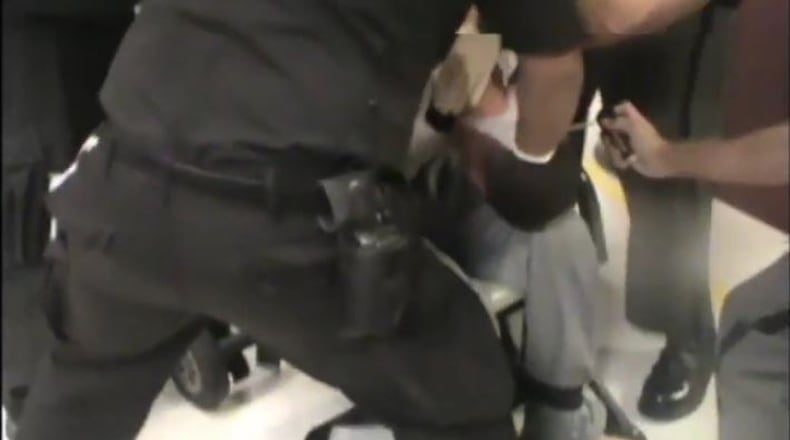Wade’s attorney, Doug Brannon, said Monday the case was settled Dec. 5. “It was an amicable settlement between the parties,” Brannon said.
A “short form settlement agreement” obtained through a public records request indicates the defendants will pay $115,000 to plaintiffs.
RELATED: Cost of lawsuits against county jail could cost $10 million, official says
A Montgomery County Prosecutor’s Office spokesman said a final settlement still must be executed.
Besides the claims against Eversole, Rose also ruled that possible civil liability claims that jail personnel may have routinely violated constitutional rights could have moved forward.
Rose dismissed defendants Sheriff Phil Plummer, then-Maj. Scott Landis and Joshua Lightner, who was trying to undo Wade’s handcuffs to strap the inmate’s hands into the harness. Rose wrote that Lightner was entitled to summary judgment because his actions could not be considered unreasonable.
VIDEO: Watch as Charles Wade is pepper-sprayed while in a restraint chair
“The same cannot be said of Eversole,” Rose wrote. “Wade was restrained, going nowhere, unarmed, surrounded by five officers, controlled by them. A jury would be entitled to find Eversole to have violated Wade’s constitutional rights based on the evidence viewed in the light most favorable to (Wade).
“Moreover, it has been established that utilizing pepper spray on a restrained inmate is an excessive use of force in violation of the Fourth Amendment.”
Eversole is married to assistant county prosecutor Erin Claypoole.
In his deposition, Wade describes the pepper spraying as a chemical burn and that his eye now twitches involuntarily.
Wade is the second former Montgomery County jail inmate to reach a legal settlement after being pepper-sprayed while restrained. On Nov. 15, 2015, then-Capt. Judith Sealey, who retired on medical disability and was found guilty of misdemeanor disorderly conduct, pepper-sprayed a fully constrained Amber Swink.
RELATED: Sheriff: Employees do an ‘excellent job’ at the jail
Video of Swink’s pepper-spraying did not surface until a few months before Wade’s incident. Swink sued the county, which paid out $375,000 in a settlement. Results of a federal investigation into the jail have never been announced.
Wade “alleges Montgomery County has an unconstitutional policy of allowing its corrections officers to use excessive force and points out that it has failed to meaningfully investigate uses of force and thus ratified all but one use of force by Montgomery County Jail officers,” Rose wrote.
Wade referred to the Swink case and six other lawsuits as evidence of the jail’s “custom of tolerance or acquiescence” toward uses of excessive force. Of the seven lawsuits, five were settled and two are pending.
RELATED: Sealey gets suspended jail sentence in misdemeanor pepper-spray case
“While the Court will not take judicial notice of these cases,” Rose wrote, “plaintiff may be able to introduce evidence from these cases or testimony regarding them at trial on the existence of a pattern of conduct.”
Rose ruled pattern or practice evidence would have only been submitted if a jury finds Eversole violated Wade’s right to be free of excessive force.
“It gives a lot of weight, in my view, that there may be some customary (practices)” of the corrections officers, University of Dayton Professor of Law Thaddeus Hoffmeister said. “So if you have a pattern, I think that goes a long way to showing that there is a custom there.”
MORE: Read other stories from Mark Gokavi
About the Author
